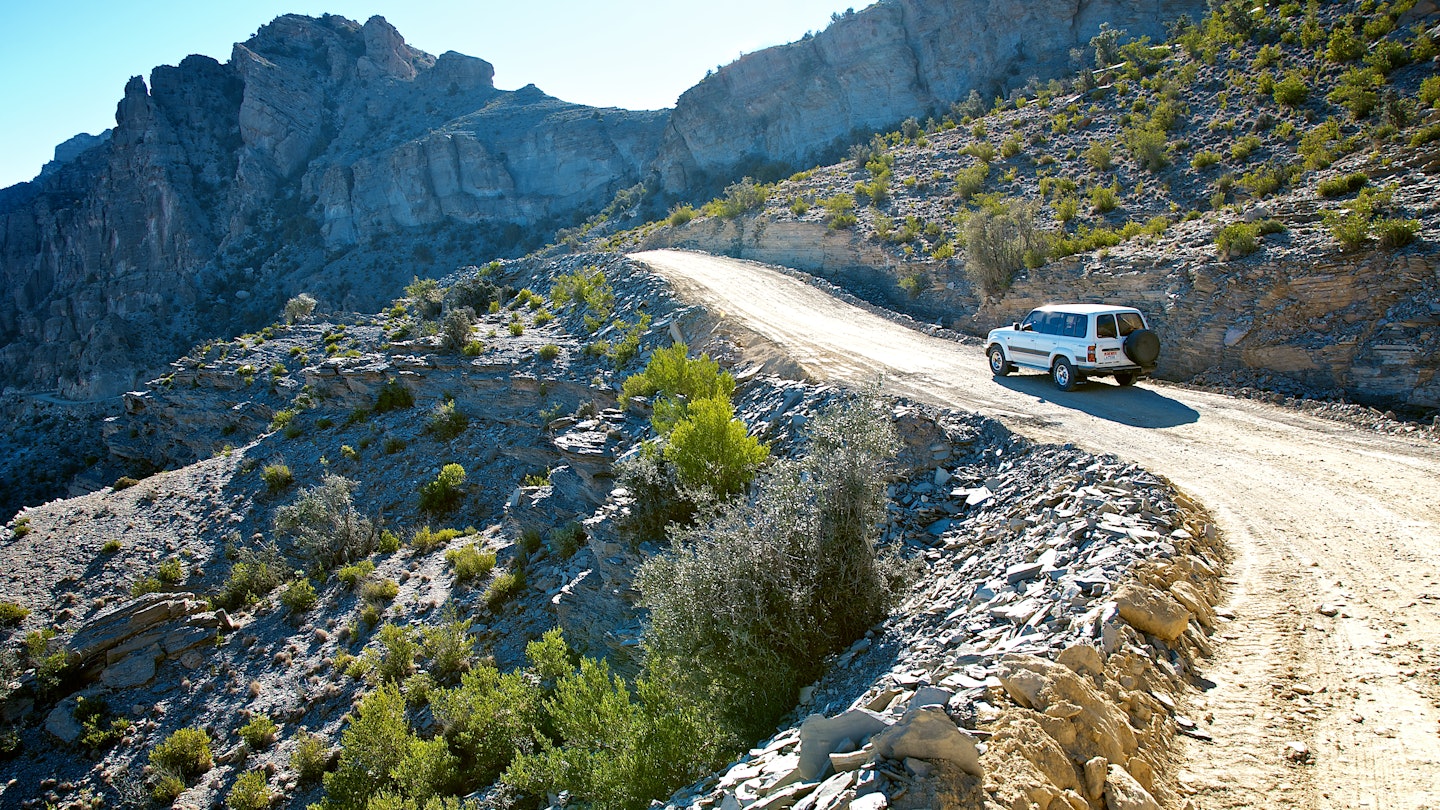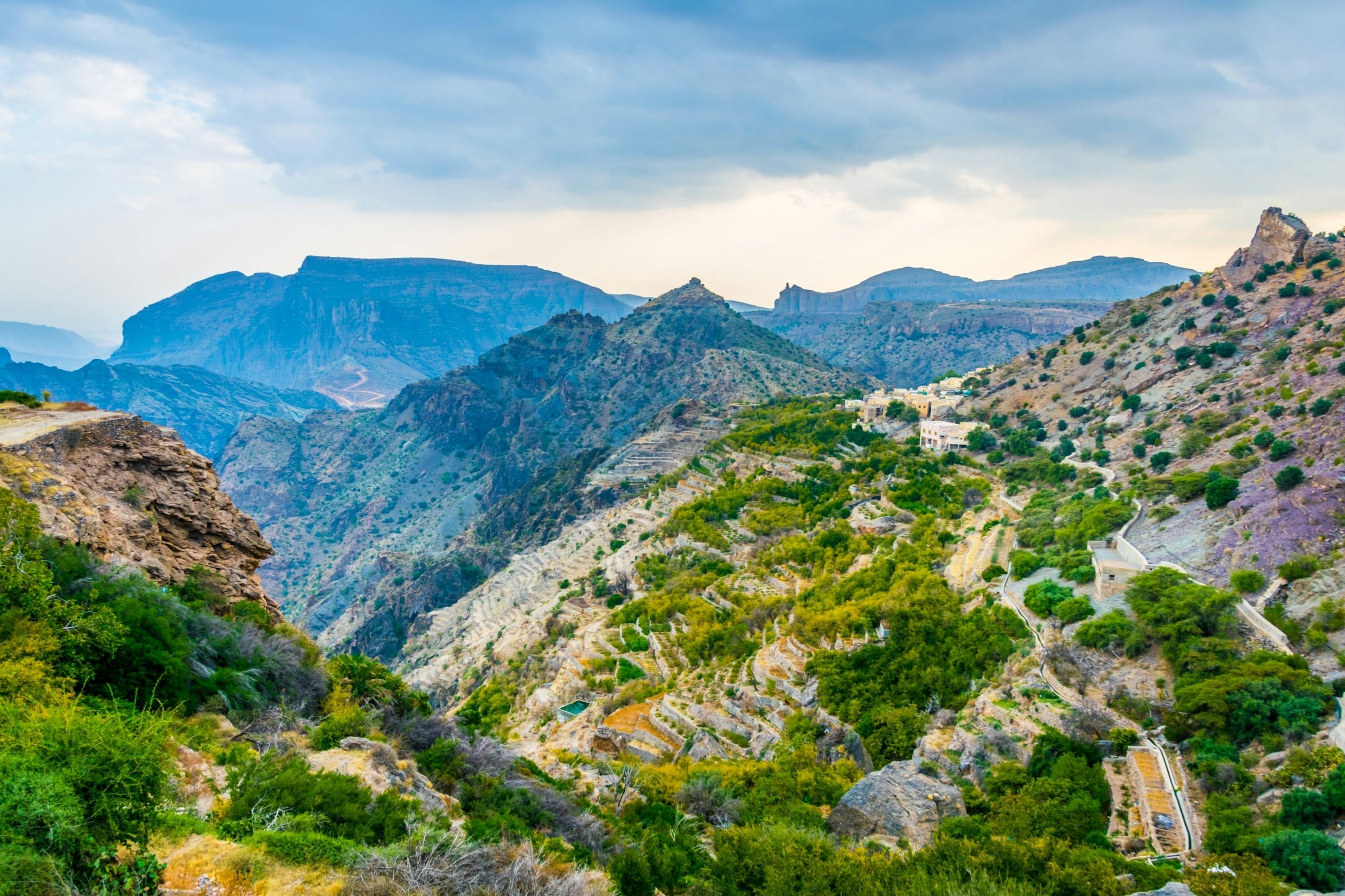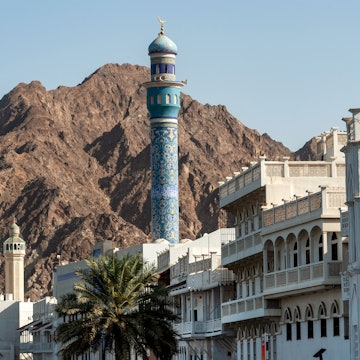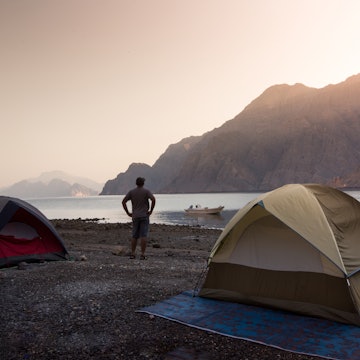

A network of excellent coastal highways and interior routes makes Oman an ideal country to road trip © arabianEye / Getty Images
There’s no better way to explore Oman’s pristine, wildly beautiful and surprisingly diverse landscapes than on a road trip. A network of excellent coastal highways and interior routes offers access to fishing villages, white-sand beaches, stunning gorges, mountain towns and lush nature reserves.
Whether you're spending one week or two in Oman, renting a car gives you maximum flexibility – something you’ll appreciate when faced with the prospect of spending an extra hour or two soaking in a turquoise spring instead of having to rush to the next spot while on a guided tour.
Road tripping also offers the opportunity to be spontaneous and wild camp around the country, and to experience the warmth and kindness of the Omani people, who are quick to invite you for a meal or tow your vehicle out of the sand should you get stuck.

Muscat to Ras Al Hadd
Best road trip if you’re short on time
Muscat – Ras Al Jinz Turtle Reserve; 379km (235 miles)
The coastal drive along Highway 17 from Muscat to Sur and farther to Ras Al Hadd, where the Gulf of Oman meets the Arabian Sea, is one of the most popular road trips in Oman for good reason. Not only do the stops along this route create a good three-day Oman road trip itinerary, but also the drive is rewarding for its spectacular scenery, especially if you don’t mind taking a few detours to the wadis (valleys) in the interior.
On your left, an azure sea hugs white-sand beaches and windswept cliffs along a coast dotted with quaint fishing towns. On your right, the eastern Hajar Mountains beckon with the promise of valley trails, mountain villages and jaw-dropping canyon views.
Stop for coffee and a quick wander around Quriyat, a fishing village with a busy souq (market), and a 19th-century fort and round watchtower. Swim in the turquoise brackish water at Bimmah Sinkhole (locally known as Hawiyat Najm Sinkhole), a natural 20m (65ft) deep limestone sinkhole that attracts visitors for the bright color of the water. Fins Beach, with its white sand, pebbles and interesting rock formations, is one of the most beautiful beaches along this coast and a good spot to camp overnight.
At Wadi Shab, hike along canyon walls to swim in turquoise pools and see a waterfall inside a cave. Visit agricultural villages at nearby Wadi Tiwi and hike past traditional falaj irrigation channels to take a dip in pristine pools surrounded by palms.
In Sur, two castles, an open-air museum and a boat-building yard where dhows (wooden boats) are still built using traditional methods tell of the town’s rich maritime heritage. Don’t leave the area without visiting Ras Al Hadd and the Ras Al Jinz Turtle Reserve, where you can witness nesting green turtles or hatchlings making their way to the sea.

Sur to Sharqiya Sands
Best road trip for desert landscapes
Sur – Al Wasil; 203km (126 miles)
For many visitors, a trip to Oman is incomplete until they’ve experienced the country’s vast desert landscape. If your interest lies more in desert than beaches, take Highway 23 from Sur and leave the coast behind to drive inland towards Sharqiya Sands. While this trip ultimately takes you to the desert, the drive there is quite beautiful with views of the rugged Hajar Mountains and interesting stops along the way.
Stop at Al Saleel National Park, a nature reserve of acacia forests, parched plateaus and rocky wadis where you can spot Arabian gazelles, red foxes and wolves.
Next, take the 30km road to Wadi Bani Khalid, where freshwater springs feed palm plantations surrounding small villages. Join picnicking families, explore a cave, swim in a series of blue-green pools or hike along the canyon.
Finally, make your way to Sharqiya Sands, where rippled orange-red dunes, some as high as 100m (328ft) serve as an astonishing introduction to Rub Al Khali. Also known as the Empty Quarter, this desert continues into the neighboring United Arab Emirates, Yemen and Saudi Arabia, and it’s the largest sand desert in the world.
To truly witness the serenity of the desert, spend a night at one of the many desert camps in the area. Beyond sandboarding and camel rides, you’ll experience Bedouin traditions around a bonfire, taste local cuisine and sleep under the stars.
You can drive in the desert at Sharqiya Sands only if you have a 4WD (deflate your tires at one of the gas pumps just before you get to the desert). If you’re driving a 2WD or aren’t confident about driving in the desert, ask your desert camp operator to pick you up from the nearby towns of Bidiyah or Al Wasil.

Nizwa to Jebel Akhdar
Best road trip for mountain villages and farms
Nizwa – Wadi Bani Habib; 67km (42 miles)
From Nizwa, Oman’s second city, the mountains are within easy reach on a day trip. While the views at Jebel Shams are spectacular, the charming villages in Jebel Akhdar will appeal to visitors who want to get a glimpse of life in the mountains. The trails past farms and through orchards deserve at least a day’s exploration and are worth the road trip.
Ascend the steep, winding road to Jebel Akhdar (Green Mountain) at a height of 2980m (9777ft) in the Hajar Mountains. The weather here is pleasant year-round with temperatures being cooler than Muscat by about 59°F (15ºC). In the heart of this rugged terrain, agricultural farms and lush fruit orchards cascade down the slopes. Above them are perched villages with mud-brick houses, offering sublime views of the valleys below. The best views are from the Saiq Plateau. Don’t miss Diana’s Point, named after the Princess of Wales who visited in 1986 and is said to have been floored by the dramatic beauty of the vista.
Trails between the villages of Al Aqur and Al Ayn take you along falaj irrigation channels, past farms growing lemons, olives, peaches and apples. The abandoned village of Wadi Bani Habib with its crumbling mud houses is known for its beautiful pomegranate and walnut orchards.
If you’re in the area from March to May, visit a distillery to see how rosewater is made using traditional methods from the pink Damask roses that bloom in the mountain this time of year. The asphalt roads are in excellent condition, but a 4WD is essential to enter the Jebel Akhdar region. A checkpoint after the town of Birkat Al Mouz enforces this.
Salalah Coast
Best road trip for the highlights of Dhofar
Salalah – Ash Shuwaymiyah; 396km (246 miles)
From Salalah, as you drive east along Highway 49, the coastline of sandy beaches, fishing towns and windswept cliffs is fringed by the cerulean waters of the Arabian Sea. On your left, are rugged mountains, wadis bearing freshwater springs and waterfalls, and ancient ruins that speak of the region’s frankincense heritage. You can camp overnight at plenty of scenic spots or rest your head in one of the pretty towns.
If you’re visiting during khareef, the monsoon season, stop by Ayn Athum Waterfall to see rain-fueled waterfalls slide down a limestone cliff into a bright blue pool surrounded by vegetation. In the fishing town of Taqah, visit the 19th-century Taqah Castle, a former residence turned into a fort museum, and stretch your legs on the white-sand beach.
Thriving with biodiversity and birdlife, Khawr Ruri, the largest of a series of lagoons along this coast, is worth a stop. Also here is an archeological site with the ruins of Sumharam, an ancient fortified port city that played a commanding role on the frankincense trading route. Head inland to Wadi Darbat to picnic lakeside and see waterfalls cascade down limestone pools, which eventually meet the sea by way of the lagoon at Khawr Ruri.
Afterwards, drive up the highest mountain in the Dhofar Governorate to marvel at the spectacular views of deep canyons, limestone cliffs and acacia forests from the Jabal Samhan Viewpoint. If you’re exceptionally lucky, you might spot the rare Arabian leopard at the Jabal Samhan Nature Reserve, home to some of the last of the species in the wild.
Stop in the fishing town of Mirbat to stroll around its harbor and admire the beautiful wooden dhows. The coast is dotted with picturesque white-sand beaches as you drive towards Ash Shuwaymiyah. From here, fishing boats can take you to Jazirat Al Hallaniyyah, also known as the Hallaniyat Islands, where humpback whale sightings are common from January to April.

Rustaq Loop
Best road trip for historic forts
Muscat – Muscat; 317km (197 miles)
If you’re interested in traditional architecture and forts, the Rustaq Loop is an easy one-day road trip that begins in Muscat and, with a few detours, takes you to a beautiful beach and scenic wadis along the way.
From Muscat, go west on Highway 1, driving along the northern coast of Oman, past the town of Seeb with its souq, sandy beach and palm-fringed corniche. After Barka, a road turns towards Al Sawadi Beach, popular with families thanks to an abundance of pretty shells on the sand. During low tide, you can wade through shallow waters to a watchtower located on an islet just off the beach.
A combination of Routes 11 and 13 takes you to three impressive and well-preserved fortified castles in the area – Al Hazm, Rustaq and Nakhal forts. Inside, sprawling courtyards, secret passageways, steep staircases, watchtowers and many rooms offer insights into life in the old days. Before you complete the loop and return to Muscat, take some time to soak in the hot springs at Al Kasfah – the sulfuric waters are believed to have healing properties.
Some forts might be temporarily closed because of restoration work, so check with the Ministry of Tourism before you go.
You might also like:
10 must-see natural wonders in Oman
The top things to do in Oman are out of this world
The 8 best places to visit in Oman: rugged mountains, seaside towns and culture-rich cities













